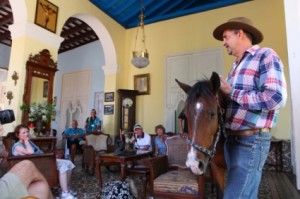
Julio Munoz and horse. Photo © Christopher P. Baker.
My friend Julio Muñoz has always had a passion for horses. He also has a knowledge of communicating with horses that is perhaps unique in Cuba. This thanks to his enthusiasm for the techniques of Monty Roberts, the impresario who has revolutionized horse-training methods with his best-selling Man Who Listens to Horses and documentaries on PBS and the BBC.Thanks to the books and videos brought by foreign guests staying at Casa Muñoz, Julio’s and his wife Rosa’s 18th-century home and room rental (casa particular), Julio was able to learn Roberts’ techniques.
On the 10-day ‘Cuba: Discover its People & Culture’ “people-to-people exchange” programs that I lead for National Geographic Expeditions, we visit with Julio to discover how he communicates with his various horses in a humane manner, encouraging a true partnership between horse and human.
The highlight is when he or his wife Rosa bring whichever horse (they own five) they have at that time in the courtyard stable and lead it into the house. Right there, in among the antique furniture and two dozen people. Guests love it!
Then Julio demonstrates his amazing communication skills with his horses, employing Monty Roberts’ “Language of Equus”—a silent language of gestures that, says, Roberts, “conveys to [the] horse a calm, confident leadership,” instilling trust in the horse and a desire to be a willing partner that will want to be with their owner.
“The key is to use the horse’s psychology,” says Julio. “The horse is a herd animal. Once you understand how horses communicate with each other through body language in the natural world, you can do amazing things.”
“With Monty Robert’s techniques I can establish a connection,” he continues. ”The horse is happy. It trusts me. It’s willing to let me do things a horse normally won’t let humans do.”
Julio moves his hands over the horse’s eyes, runs his hands down its legs, and even puts his hand into the horse’s mouth and grabs the thick, wet tongue. All places that horses don’t normally like to be touched.
Most important, Julio explains, is love. Lots of love. And never pain. “Never give pain to the horse!” he stresses.
Julio tries to spread the word to local campesinos (peasant farmers) through his Proyecto Diana, named for his first horse, which died of colic.
Says Julio: “The traditional method of ‘breaking’ in a horse causes pain and damage. We show other horse owners that it is possible to train a horse without using violent, traditional methods, and that we can mount a new horse in a far shorter time than a horse that is ‘broken’ through pain and submission.”
Julio jokes about how the campesinos get out the tools he’s given them when they know he’s about to visit, but it clearly pains him that few actually use them and that few have adopted his progressive, more humane, methods.
It’s slow progress. Still, he doesn’t give up. He continues to teach through example, hoping his methods will catch on.
Julio explains to our groups that there are relatively few veterinarians and even fewer medicines available in Cuba. Hence many campesinos use relatively useless and potentially harmful ‘home remedies.’ And sick or injured horses are left to die, or are killed, simply because the owners don’t have the means to cure them.
On my last visit, just two weeks ago, Julio had recently rescued a young half-starved foal that had been trapped in mud and which the owner had left to die.
Our National Geographic Expeditions participants looked on in awe as Julio led the foal out of the stable to demonstrate, yet again, the remarkable bond and affection he has established between man and horse.
Proyecto Diana needs donations of proper shoeing and other farrier tools, which are almost entirely lacking in Cuba.
You can contact Julio Muñoz directly:
Calle Jose Marti # 401, Trinidad, Sancti Spíritus
Tel +53 41 99-3673 ( International)
E-mail: [email protected]